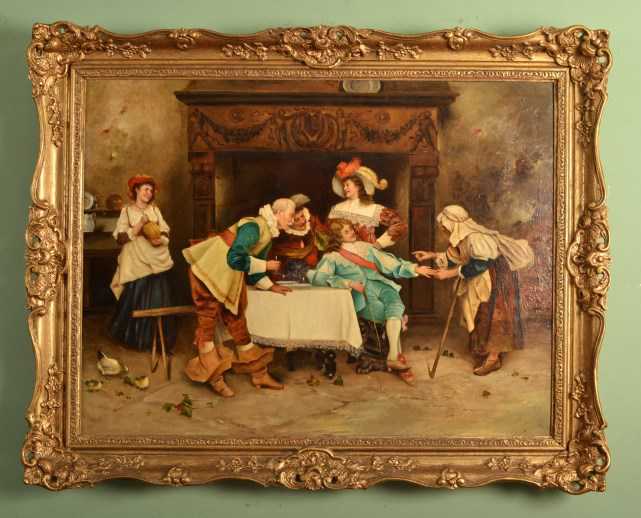How to Identify Antique Oil Paintings: Quick Tips
- Posted on 26th January 2023
- in Antique Oil Paintings, Antique Paintings, Chinese Landscape Paintings
- by Alan
With antique oil paintings, the composition, condition, and artist can all have a great impact on the value. We love identifying pieces brought to us by our Florida clients, especially when it is a particularly old or rare artistic work. We also understand that people are naturally curious; whether the piece was found by an amateur at a local estate liquidation, or it is part of a collection, the owner will want to find out as much information about the piece as possible.
While you should always minimize contact with historical oils, and leave any in-depth or invasive inspections and restorations to a professional Florida conservator, it’s nice to know how to properly handle and inspect your piece. So this is a quick overview of how to go about identifying different aspects of antique oil paintings.

Image Source: https://bit.ly/3BVekkV
Safety First
When handling any delicate antique oil painting, it’s important to prevent acidic skin oils transferring to the piece. Nitrile gloves work well for this. Although they wear out sooner than cotton gloves, they tend to allow for a better grip. If you need to take down any artwork, retain a firm grip with one hand at the base of the frame, and the other on one side. Be sure to prepare a padded, yet stable, surface to set it on before you begin. If you’re unsure about your ability to safely handle the piece, please call an Florida professional.
Color and Content
When a piece is not one that was created by a famous artist, both the content and color greatly influence its desirability. Quite often landscapes, with bright, contrasting colors will command a higher price. Likewise, beauty will sell far easier than anything that is mundane, has muted colors, or depicts unappealing or controversial topics.
Size
Larger does not always command a higher price. For most homes, medium to small pieces fit far better than any of the much larger works. This is why, in Florida and other major cities, antique oil paintings such as full length portraits or sprawling landscapes are mostly found only in museums or public buildings.
Inspection
It’s important to realize that the condition can vary drastically based on two things. How the antique oil painting has been cared for since its completion, and the artist’s construction of the work. Either of these can easily negate the other. If constructed poorly, no amount of care can prevent it from degrading, while even the most delicately prepared piece will wear heavily when badly cared for.
Cracks and loss of paint are usually obvious when closely inspected, but often an exam under normal light isn’t enough. Here’s an easy trick: Find a strong light source, such as a lamp or bright window, and hold the canvas up to it. It needs to be bright and close enough to allow light to be seen through the cracks, while remaining far enough away that you don’t risk bumping the painting against the window or light source. Remember that cracking due to age is unavoidable; cracks should be visible, but flakes should be secure, not falling away easily.
Varnish is usually used to protect antique oil paintings, but as it ages it becomes brittle, loses the ability to protect, and the clear coat turns an ugly yellow. This obscures and dulls the colors of the work, making it appear muted and shallow. Fortunately, this malady is only temporary, as a conservator in the Florida area would be able to remove the old varnish and apply a fresh, clear coat, restoring any lost vibrancy.
Support
Of the two types of supports that are commonly used (fabric and wood), both have the potential to damage the work if not properly cared for. Wood should be closely examined for cracks and wormholes, as well as any markings that might indicate the artist while you’re at it. If the back panel is improperly sealed, there are two types of damage that can occur. In areas of high humidity like Florida, moisture is absorbed into the wood causing it to expand. This warps the wood, pushing the paint together and causing it to lift away from the page in the form of small ripples. The reverse happens in dry environments, where the shrinking wood pulls the oil apart, creating cracks.
Tags: antique buyer, antique dealer, antique oil painting, Sarasota Antique Buyers
